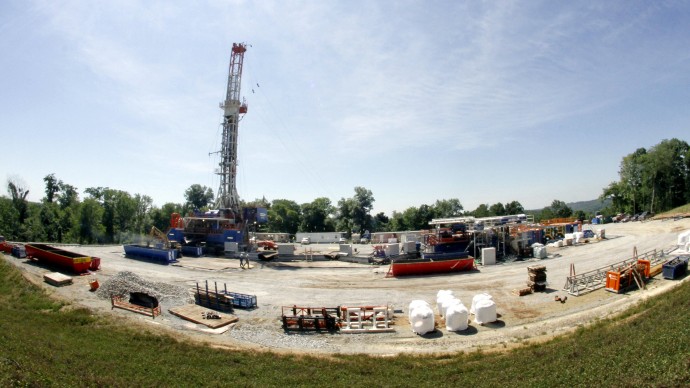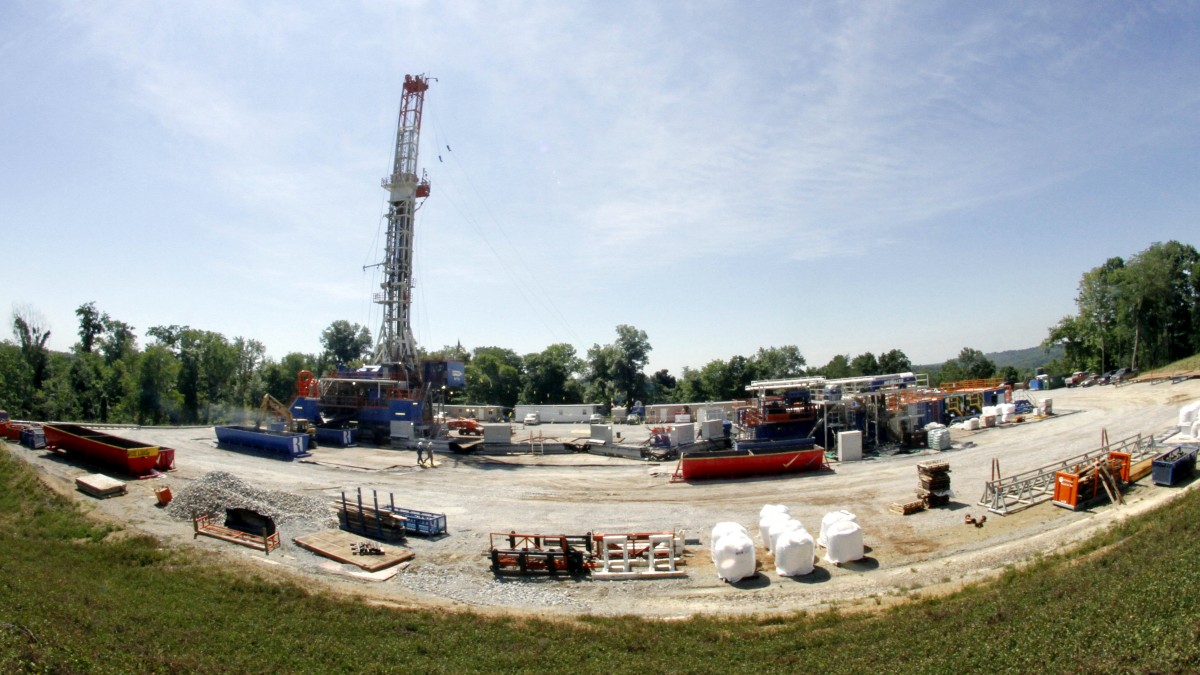
(MintPress) — An estimated 5,000 activists demonstrated in Washington D.C. July 27-29 to demand a national ban on hydraulic fracturing. Stop the Frack Attack, a national coalition of more than 136 environmental, social and faith-based organizations, issued a collective demand of Congress: Ban fracking because of environmental and human health concerns.
However, as the public debate continues, industry officials charge that many of the environmental studies have unnecessarily inflated the risk of fracking, hampering the development of domestic gas sources.
As a patchwork of cities and towns continue to pass anti-fracking development in the Northeast and Mid-Atlantic states, a major development by the Petro River Oil is underway in Kansas and Oklahoma. The development, project leaders contend, is safe and important for communities in need of jobs and domestic sources of energy.
The Mississippi Lime
Although not as big as the Marcellus shale reserve stretching across New York, Ohio, Pennsylvania and West Virginia — the Mississippi Lime formation is projected to conservatively produce 90,000 barrels of gas through conventional drilling methods in the Northern Kansas region.
Fracking could produce an additional 80,000 barrels of natural gas per day in Oklahoma. However, industry officials call this a “conservative” estimate of the yield potentials.
Despite the strong yield potentials, the environmentalist community remains steadfast in its opposition to natural gas development. Despite industry claims to the contrary, many within the environmentalist community contend that fracking can produce contaminated drinking water, low level earthquakes and increased levels of carbon-dioxide in the atmosphere.
Ruben Alba, co-CEO and Director working on the Petro River Oil project, commented on the development in a MintPress interview, saying, “No one field is going to change the direction of the industry overnight. it is going to take thousands of wells. We are going to see the wells greatly improve the trade deficit of the U.S. We are also seeing huge leaps and bounds in production.”
Alba, who has served as a chemical engineer, contends that the large “elephant fields” yielding huge quantities of oil and gas are exceedingly rare and unlikely to be found in the region.
Officials could not give an accurate estimate on the number of jobs created. However, the company has reportedly made a commitment to keep labor patriated to each state, within a 100-mile radius of the fracking sites.
Many of the local communities in Kansas and Oklahoma are rural communities suffering high unemployment. The Bureau of Labor Statistics estimates that national unemployment stands at 8.3 percent.
Rajiv Srinivasan, an Afghanistan war veteran and founder of the National Foundation for Veteran Redeployment, has helped to develop the veteran hiring policy for Petro River Oil.
There are currently 240,000 unemployed veterans. However, Srinivasan believes that the oil and gas industry could help curb veteran unemployment significantly by putting 2-3 percent of unemployed veterans back to work on fracking construction sites.
This model for veteran hiring, if applied by every industry, could provide resources and economic opportunities for our unemployed veterans, Srinivasan said in a MintPress statement.
Petro River Oil has put 60 veterans back to work and hopes to expand veteran hiring practices through an online database available to active duty soldiers and recently returned soldiers.
Increases in natural gas use
The United States possesses enormous natural gas reserves, lagging behind only Russia and China. According to the latest geological estimates, the United States has 37 million cubic meters of conventional natural gas and another 37 million of unconventional gas, according to the Economist Magazine special feature on natural gas, titled, “An Unconventional Bonanza.”
The conventional gas can be extracted through normal, vertical drilling methods while the unconventional requires horizontal drilling methods, or “fracking to extract.”
Activists claim that a loophole in the 2005 Clean Air and Water Act exempts Halliburton and other companies involved in fracking projects from complying to legal environmental requirements.
The European Union has taken the lead in transitioning to cleaner forms of energy. The strong green movement in Europe has prompted EU leaders to pledge that 97 percent of power generation will come from renewable sources such as solar and wind power by 2050.
Many countries, including Bulgaria, the Czech Republic and France, have placed moratoriums on fracking. Germany has taken the strongest stance against the practice, opting to ban fracking altogether earlier this year.
The state of Vermont has taken the lead nationally, becoming the first state to ban fracking extraction. When presented with the grassroots action of Vermont, Alba dismissed them, saying, “Vermont also used to burn witches at the stake.”
Conversely, New York appears poised to greenlight fracking projects in the lower tier of the state near the Pennsylvania border. Gov. Andrew Cuomo announced that he would reveal plans after Labor Day, overturning a moratorium that has been in place since 2008.
Hundreds of towns and villages throughout New York have already banned fracking. These bans are expected to be honored by the state.
Despite these restrictions by European countries and some locales in the U.S., the International Energy Agency (IEA) projects that natural gas production will comprise a larger share of global energy production, increasing from current levels of 21 percent to 25 percent in 2035.
What is fracking?
Hydraulic fracturing, commonly known as “fracking,” is a process of horizontal natural gas drilling. Drills are used to bore deep into the earth where “fracking fluid” is injected, causing underground rock formations to break apart due to pressure. The resulting fissures allow trapped natural gas to escape where it can be collected and used for energy.
Although the process has been used in various forms since the 1950s, many environmentalists take issue with the composition of “fracking fluid,” long held as a trade secret by gas companies. Chemical analyses have shown that this fluid, while composed mostly of water and other non-toxic materials, contains smaller amounts of 29 harmful chemicals, including Benzene, Xylene and Ethylbenzene.
A scientific investigation published April 2011 by the U.S. House of Representatives Committee On Energy and Commerce, found:
“The oil and gas service companies used hydraulic fracturing products containing 29 chemicals that are (1) known or possible human carcinogens, (2) regulated under the Safe Drinking Water Act for their risks to human health or (3) listed as hazardous air pollutants under the Clean Air Act. These 29 chemicals were components of 652 different products used in hydraulic fracturing.”
Petro River Oil officials claim that the gas industry has mostly eradicated the use of carcinogenic DETEX chemicals, revising their fracking fluid formulas to include more benign, non-toxic substances.
Industry officials, including Alba, also claim that fracking fluids are unlikely to reach aquifers and fresh water supplies closer to the earth’s surface. However, these claims directly contradict the findings of a peer reviewed study published in the April edition of Ground Water, a journal of the National Groundwater Association.
“Scientists have theorized that impermeable layers of rock would keep the fluid, which contains benzene and other dangerous chemicals, safely locked nearly a mile below water supplies. But the study, using computer modeling, concluded that natural faults and fractures in the Marcellus, exacerbated by the effects of fracking itself, could allow chemicals to reach the surface in as little as just a few years,” the report concluded.
The study’s author, Tom Myers, is an independent hydrogeologist who has previously conducted studies for the federal government and environmental groups.
Other studies have also found that fracking can cause tremors and low level earthquakes.
Expanding dialogue industry reforms
When presented with these data, industry officials chalked up the findings to “misinformation” or a general lack of understanding about the fracking process.
Alba commented on this issue in a MintPress statement saying, “People have a general misunderstanding of the fracking process. It is a very huge issue for a number of reasons. The oil and gas industry has always worn a target on its back.”
As communities and state governments continue to sift through the bevy of scientific data, industry statistics and public opinion polling, one definitive announcement by the insurance industry sheds light on the risks of fracking.
Nationwide Insurance, one of the largest insurance companies in the U.S., announced its decision to not cover damages related to hydraulic fracturing. The decision was made public last month when an internal company memo was leaked to the public.
Since then, the memo has been widely disseminated through online environmentalist forums and is seen by anti-fracking activists as legitimizing their belief that the practice is harmful to human health and the environment.
The memo reads, “After months of research and discussion, we have determined that the exposures presented by hydraulic fracturing are too great to ignore. Risks involved with hydraulic fracturing are now prohibited for General Liability, Commercial Auto, Motor Truck Cargo, Auto Physical Damage and Public Auto (insurance) coverage.”
While this memo has been treated by some as proof positive that fracking is an unsafe method of gas extraction, the debate continues to unfold.
One area all sides seem to agree on is a need for more independent testing and increased conversation among gas companies, local communities and environmentalists. When asked about the Petro River Oil’s commitment to more testing by universities, Alba affirmed the Petro River Oil commitment saying:
“I would wholeheartedly agree with the notion that there needs to be more testing by independent studies. We welcome and want statements being made in an educated fashion. We want as many views as possible, this is going to help clarify the issues. It is also going to help regulate the industry.”
This belief in more independent testing corresponds closely to public opinion on this issue.
In New York state, one of the contested fracking areas, the latest public opinion polls show 48 percent of New Yorkers oppose the practice altogether. Forty-four percent support the practice, while the remaining 8 percent are unsure.
In the same telephone poll, conducted June 15-17 by Public Policy Polling, 72 percent of respondents support more environmental testing on fracking before the state makes a decision on whether to allow drilling or not.


